Coseismic Deformation Monitoring and Seismogenic Fault Parameter Inversion Using Lutan-1 Data: A Comparative Analysis with Sentinel-1A Data
Abstract
:1. Introduction
2. Dataset and Study Aera
2.1. SAR Data
2.2. Summary of the Study Area
3. Method and Results
3.1. InSAR Data Processing
3.1.1. Differential Interferograms with Lutan-1 Data
3.1.2. Baseline Deviation and Atmosphere Phase Correction
3.1.3. Coseismic Deformation Fields
3.2. Inversion of Seismogenic Fault Parameters
3.2.1. Uniform Slip Modeling
3.2.2. Distributed Slip Modeling
4. Discussion
4.1. Comparative Analysis of SAR Intensity Images
4.2. Comparative Analysis of Coherence
4.3. Comparative Analysis of Atmospheric Phase
4.4. Comparative Analysis of Coseismic Deformation Field
5. Conclusions
Author Contributions
Funding
Data Availability Statement
Acknowledgments
Conflicts of Interest
References
- Li, M.; Wang, Y.; Li, W.; Jiang, K.; Zhang, Y.; Lyu, H.; Zhao, Q. Performance evaluation of real-time orbit determination for LUTAN-01B satellite using broadcast earth orientation parameters and multi-GNSS combination. GPS Solut. 2023, 28, 52. [Google Scholar] [CrossRef]
- Zhang, Y.; Li, Y.; Chen, Z.; Zhao, X.; Liu, Y.; Hu, C. First Result of Lutan-1 Space-Surface Bistatic SAR Interferometry. In Proceedings of the IGARSS 2023—2023 IEEE International Geoscience and Remote Sensing Symposium, Pasadena, CA, USA, 17–21 July 2023; pp. 7860–7863. [Google Scholar]
- Deng, Y.; Wang, Y. Key technologies for spaceborne SAR payload of LuTan-1 satellite system. Acta Geod. Cartogr. Sin. 2024, 53, 1881–1895. [Google Scholar]
- Mou, J.; Wang, Y.; Hong, J.; Wang, Y.; Wang, A.; Sun, S.; Liu, G. First Assessment of Bistatic Geometric Calibration and Geolocation Accuracy of Innovative Spaceborne Synthetic Aperture Radar LuTan-1. Remote Sens. 2023, 15, 5280. [Google Scholar] [CrossRef]
- Ji, Y.; Zhang, X.; Li, T.; Fan, H.; Xu, Y.; Li, P.; Tian, Z. Mining Deformation Monitoring Based on Lutan-1 Monostatic and Bistatic Data. Remote Sens. 2023, 15, 5668. [Google Scholar] [CrossRef]
- Wang, R.; Liu, K.; Liu, D.; Ou, N.; Yue, H.; Chen, Y.; Yu, W.; Liang, D.; Cai, Y. LuTan-1: An innovative L-band spaceborne bistatic interferometric synthetic aperture radar mission. IEEE Geosci. Remote Sens. Mag. 2025, 2–22. [Google Scholar] [CrossRef]
- Liu, B.; Zhang, L. Application of InSAR Monitoring Large Deformation of Landslides Using Lutan-1 Constellation. Geomat. Inf. Sci. Wuhan Univ. 2024, 49, 1753–1762. [Google Scholar]
- Yu, Z.; Yan, L. Research and application of Lutan-1 SAR satellite in survey andmonitoring of catastrophic geohazards. Bull. Surv. Mapp. 2024, 11, 97–101. [Google Scholar]
- Li, T.; Tang, X.; Zhou, X.; Zhang, X.; Li, S.; Gao, X. Deformation Products Of Lutan-1(Lt-1) Sar Satellite Constellation for Geohazard Monitoring. In Proceedings of the IGARSS 2022—2022 IEEE International Geoscience and Remote Sensing Symposium, Kuala Lumpur, Malaysia, 17–22 July 2022; pp. 7543–7546. [Google Scholar]
- Xu, B.; Liu, L.; Li, Z.; Zhu, Y.; Hou, J.; Mao, W. Design Bistatic Interferometric DEM Generation Algorithm and Its Theoretical Accuracy Analysis for LuTan-1 Satellites. J. Geod. Geoinf. Sci. 2022, 5, 25–38. [Google Scholar]
- Li, Y.; Liu, H.; Yang, C. Revisiting the seismic hazards of faults surrounding the 2022 Ms6.8 Luding earthquake, Sichuan, China. Geomat. Nat. Hazards Risk 2023, 14, 2272569. [Google Scholar] [CrossRef]
- Zhang, Y.; Zhang, G.; Hetland, E.A.; Shan, X.; Zhang, H.; Zhao, D.; Gong, W.; Qu, C. Source Fault and Slip Distribution of the 2017 Mw 6.5 Jiuzhaigou, China, Earthquake and Its Tectonic Implications. Seismol. Res. Lett. 2018, 89, 1345–1353. [Google Scholar] [CrossRef]
- Daoyang, Y.; Peizhen, Z. A preliminary study on the new activity features of the Lajishan mountain fault zone in Qinhai Province. Earthq. Res. 2005, 32, 93–102. [Google Scholar]
- Zhang, Z.; Zeng, Q.; Jiao, J. Deformations monitoring in complicated-surface areas by adaptive distributed Scatterer InSAR combined with land cover: Taking the Jiaju landslide in Danba, China as an example. ISPRS J. Photogramm. Remote Sens. 2022, 186, 102–122. [Google Scholar] [CrossRef]
- Su, Y.; Peng, J.; Shi, M.; Guo, C.; Ma, X.; Li, X.; Wang, J.; Wang, W. An M-Estimation Method for InSAR Nonlinear Deformation Modeling and Inversion. IEEE Trans. Geosci. Remote Sens. 2024, 62, 5207912. [Google Scholar] [CrossRef]
- Zhu, C.H.; Wang, C.S.; Zhang, B.C.; Qin, X.Q.; Shan, X.J. Differential Interferometric Synthetic Aperture Radar data for more accurate earthquake catalogs. Remote Sens. Environ. 2021, 266, 112690. [Google Scholar] [CrossRef]
- Morishita, Y. A Systematic Study of Synthetic Aperture Radar Interferograms Produced From ALOS-2 Data for Large Global Earthquakes From 2014 to 2016. IEEE J. Sel. Top. Appl. Earth Obs. Remote Sens. 2019, 12, 2397–2408. [Google Scholar] [CrossRef]
- Zhou, Y.; Zhou, C.; E, D.; Wang, Z. A Baseline-Combination Method for Precise Estimation of Ice Motion in Antarctica. IEEE Trans. Geosci. Remote Sens. 2014, 52, 5790–5797. [Google Scholar] [CrossRef]
- Ma, X.; Peng, J.; Su, Y.; Shi, M.; Zheng, Y.; Li, X.; Jiang, X. Deformation Characteristics and Activation Dynamics of the Xiaomojiu Landslide in the Upper Jinsha River Basin Revealed by Multi-Track InSAR Analysis. Remote Sens. 2024, 16, 1940. [Google Scholar] [CrossRef]
- Zheng, Y.; Peng, J.; Chen, X.; Huang, C.; Chen, P.; Li, S.; Su, Y. Spatial and Temporal Evolution of Ground Subsidence in the Beijing Plain Area Using Long Time Series Interferometry. IEEE J. Sel. Top. Appl. Earth Obs. Remote Sens. 2023, 16, 153–165. [Google Scholar] [CrossRef]
- Huang, X.; Li, Y.; Shan, X.; Zhong, M.; Wang, X.; Gao, Z. Fault Kinematics of the 2023 Mw 6.0 Jishishan Earthquake, China, Characterized by Interferometric Synthetic Aperture Radar Observations. Remote Sens. 2024, 16, 1746. [Google Scholar] [CrossRef]
- Liu, Z.; Bingquan, H.; Yihan, N.; Zhenhong, L.; Chen, Y.; Chuang, S.; Bo, C.; Lijiang, Z.; Xuesong, Z.; Jianbing, P. Source Parameters and Slip Distribution of the 2023 Mw 6.0 Jishishan (Gansu, China) Earthquake Constrained by InSAR Observations. Geomat. Inf. Sci. Wuhan Univ. 2025, 50, 344–355. [Google Scholar] [CrossRef]
- Fang, N.; Kai, S.; Chuanchao, H.; Chengyuan, B.; Zhidan, C.; Lei, X.; Zhi, Y.; Yinghui, X.; Hongbin, X.; Guangcai, F.; et al. Joint Inversion of InSAR and Seismic Data for the Kinematic Rupture Process of the 2023 Ms 6.2 Jishishan Earthquake. Geomat. Inf. Sci. Wuhan Univ. 2025, 50, 333–343. [Google Scholar] [CrossRef]
- Lease, R.O.; Burbank, D.W.; Clark, M.K.; Farley, K.A.; Zheng, D.; Zhang, H. Middle Miocene reorganization of deformation along the northeastern Tibetan Plateau. Geology 2011, 39, 359–362. [Google Scholar] [CrossRef]
- Wang, M.; Shen, Z.K. Present-Day Crustal Deformation of Continental China Derived From GPS and Its Tectonic Implications. J. Geophys. Res. Solid Earth 2020, 125, e2019JB018774. [Google Scholar] [CrossRef]
- Daoyang, Y.; Peizhen, Z. Late Cenozoic tectonic deformation of the Linxia Basin, northeastern margin of the Qinghai-Tibet Plateau. Earth Sci. Front. 2007, 14, 243–250. [Google Scholar]
- Zheng, D.; Peizhen, Z. Tectonic events, climate and conglom erate: Example from Jishishan and mountain and Linxia basin. Quat. Sci 2006, 26, 63–69. [Google Scholar]
- Li, M.; Gao, Y. Basic Characteristics of Tectonics and Seismie Anisotropy inthe Southeastern Margin of the Qinghai-Tibet Plateau. Earthquake 2021, 41, 15–45. [Google Scholar]
- Bai, Y.; Ni, H. Advances in Research on the Geohazard Effect of Active Faults on the Southeastern Margin of the Tibetan Plateau. J. Geomech. 2019, 25, 1116–1128. [Google Scholar]
- Saylor, J.E.; Jordan, J.C.; Sundell, K.E.; Wang, X.; Wang, S.; Deng, T. Topographic growth of the Jishi Shan and its impact on basin and hydrology evolution, NE Tibetan Plateau. Basin Res. 2017, 30, 544–563. [Google Scholar] [CrossRef]
- Zhuang, W.; Cui, D.; Hao, M.; Song, S.; Li, Z. Geodetic constraints on contemporary three-dimensional crustal deformation in the Laji Shan–Jishi Shan tectonic belt. Geod. Geodyn. 2023, 14, 589–596. [Google Scholar] [CrossRef]
- Peizhen, Z.; Daoyang, Y. Discussion on late Cenozoic growth and rise of northeastern margin of the Tibetan Plateau. Quat. Sci. 2006, 26, 5–13. [Google Scholar]
- Bai, Z.; Ji, L.; Zhu, L.; Chen, H.; Xu, C.; Bian, Z.; Wang, J. Study on the process and mechanism of slip-mudflow in Zhongchuan Township induced by the Jishishan earthquake in 2023. China Earthq. Eng. J. 2024, 46, 768–777. [Google Scholar] [CrossRef]
- Wang, X.; Flynn, L.J.; Deng, C. A review of the Cenozoic biostratigraphy, geochronology, and vertebrate paleontology of the Linxia Basin, China, and its implications for the tectonic and environmental evolution of the northeastern margin of the Tibetan Plateau. Palaeogeogr. Palaeoclimatol. Palaeoecol. 2023, 628, 111775. [Google Scholar] [CrossRef]
- Werner, C.; Wegmüller, U.; Strozzi, T.; Wiesmann, A. GAMMA SAR and Interferometric Processing Software. In Proceedings of the ERS-Envisat Symposium, Gothenburg, Sweden, 16–20 October 2000. [Google Scholar]
- Scheiber, R.; Bothale, V.M. Interferometric Multi-look Techniques for SAR Data. In Proceedings of the IEEE International Geoscience and Remote Sensing Symposium, Toronto, ON, Canada, 24–28 June 2002; pp. 173–175. [Google Scholar]
- Wright, T.J. Remote monitoring of the earthquake cycle using satellite radar interferometry. Philos. Trans. R. Soc. A Math. Phys. Eng. Sci. 2002, 360, 2873–2888. [Google Scholar] [CrossRef] [PubMed]
- Massonnet, D.; Feigl, K.L. Radar interferometry and its application to changes in the Earth’s surface. Rev. Geophys. 1998, 36, 441–500. [Google Scholar] [CrossRef]
- Zebker, H.A.; Rosen, P.A.; Hensley, S. Atmospheric effects in interferometric synthetic aperture radar surface deformation and topographic maps. J. Geophys. Res. Solid Earth 1997, 102, 7547–7563. [Google Scholar] [CrossRef]
- Wegmuller, U.; Walter, D.; Spreckels, V.; Werner, C.L. Nonuniform Ground Motion Monitoring With TerraSAR-X Persistent Scatterer Interferometry. IEEE Trans. Geosci. Remote Sens. 2010, 48, 895–904. [Google Scholar] [CrossRef]
- Okada, Y. Surface Deformation Due to Shear and Tensile Faults in a Half-Space. Bull. Seismol. Soc. Am. 1985, 75, 1135–1154. [Google Scholar] [CrossRef]
- Bagnardi, M.; Hooper, A. Inversion of Surface Deformation Data for Rapid Estimates of Source Parameters and Uncertainties: A Bayesian Approach. Geochem. Geophys. Geosyst. 2018, 19, 2194–2211. [Google Scholar] [CrossRef]
- Rongjiang, W.; Diao, F.; Hoechner, A. SDM—A geodetic inversion code incorporating with layered crust structure and curved fault geometry. In Proceedings of the EGU General Assembly Conference, Vienna, Austria, 7–12 April 2013; Volume 15. [Google Scholar]
- Wang, R.; Lorenzo-Martín, F.; Roth, F. PSGRN/PSCMP—A new code for calculating co- and post-seismic deformation, geoid and gravity changes based on the viscoelastic-gravitational dislocation theory. Comput. Geosci. 2006, 32, 527–541. [Google Scholar] [CrossRef]
- Feng, S.; Dai, K.; Sun, T.; Deng, J.; Tang, G.; Han, Y.; Ren, W.; Sang, X.; Zhang, C.; Wang, H. Mini-Satellite Fucheng 1 SAR: Interferometry to Monitor Mining-Induced Subsidence and Comparative Analysis with Sentinel-1. Remote Sens. 2024, 16, 3457. [Google Scholar] [CrossRef]
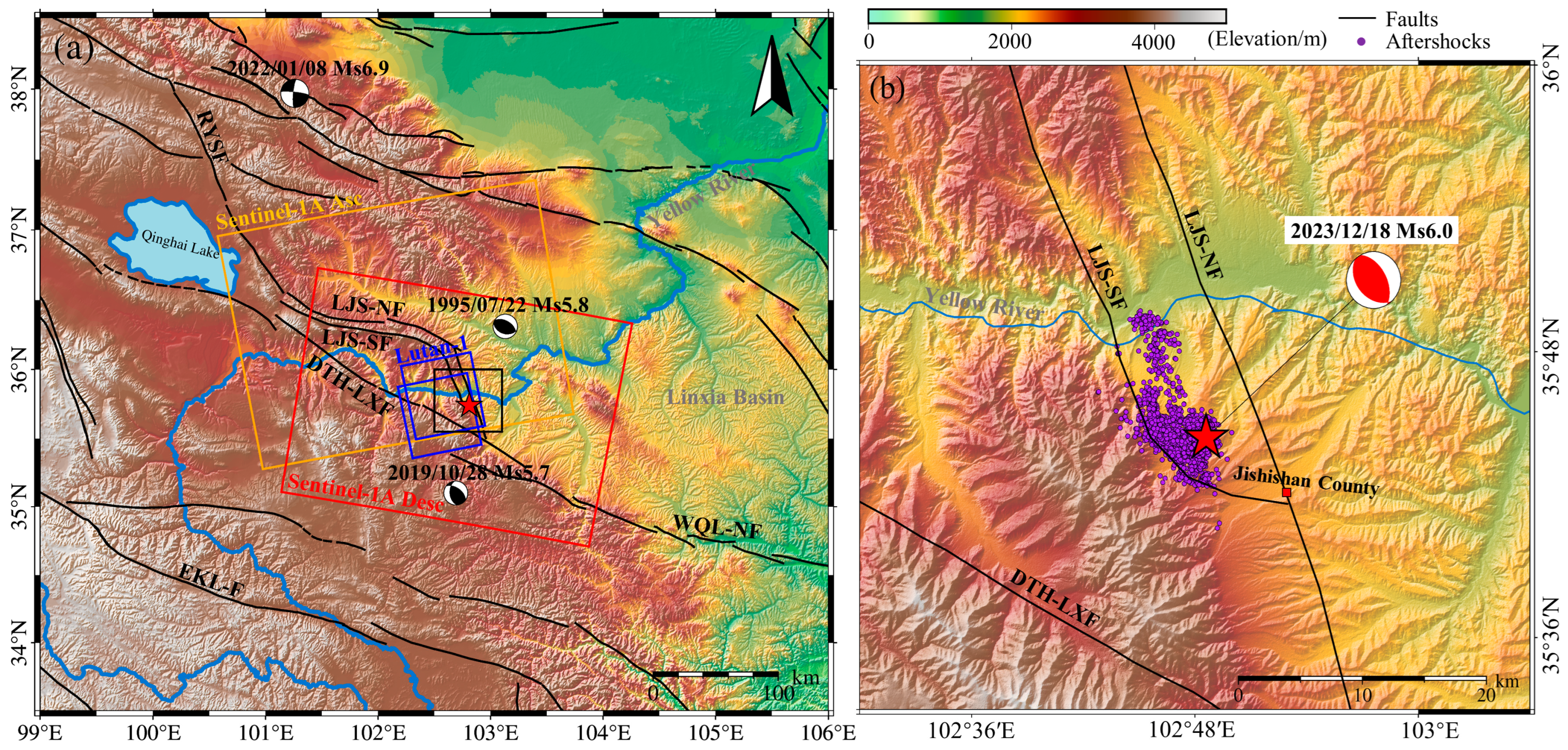

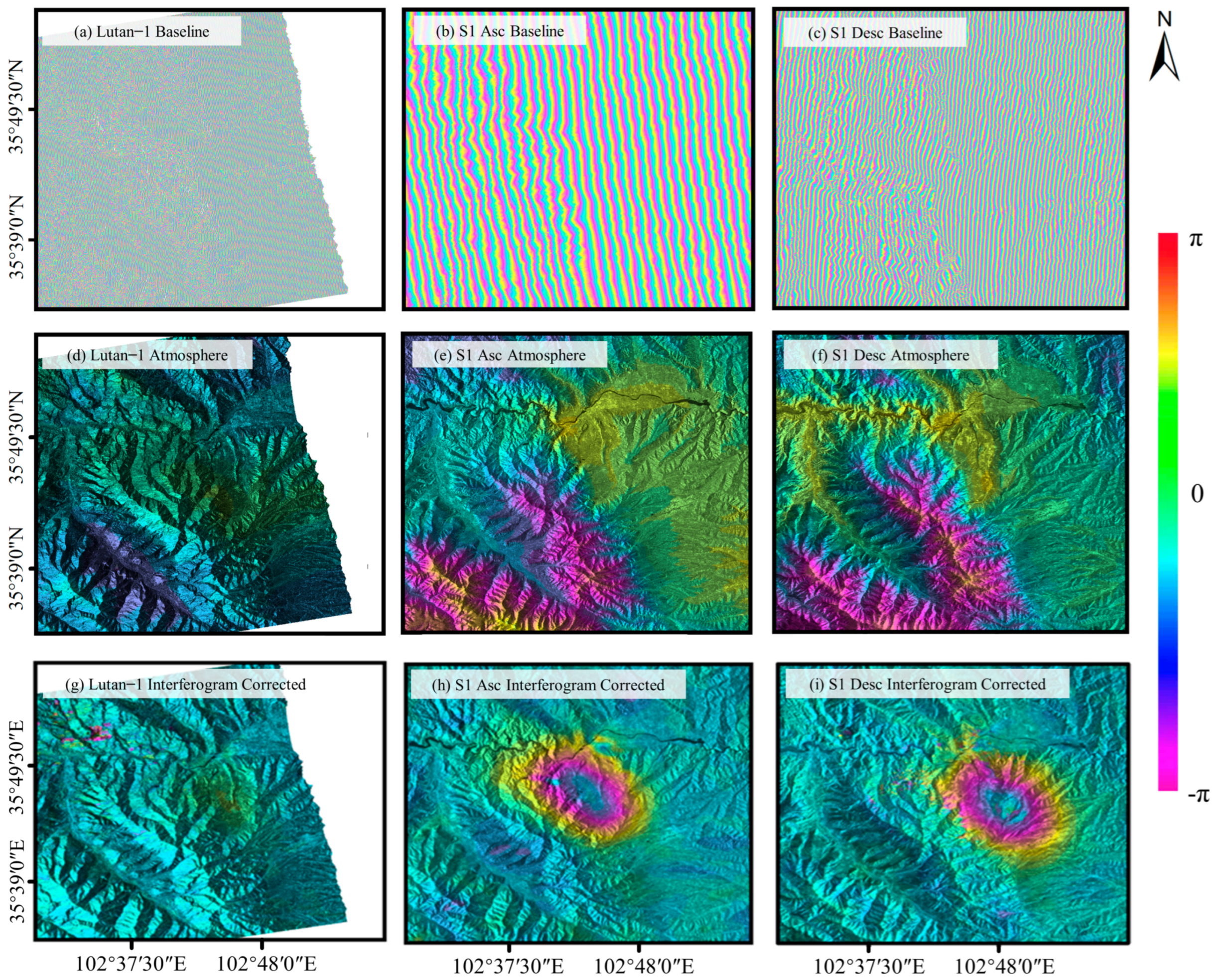

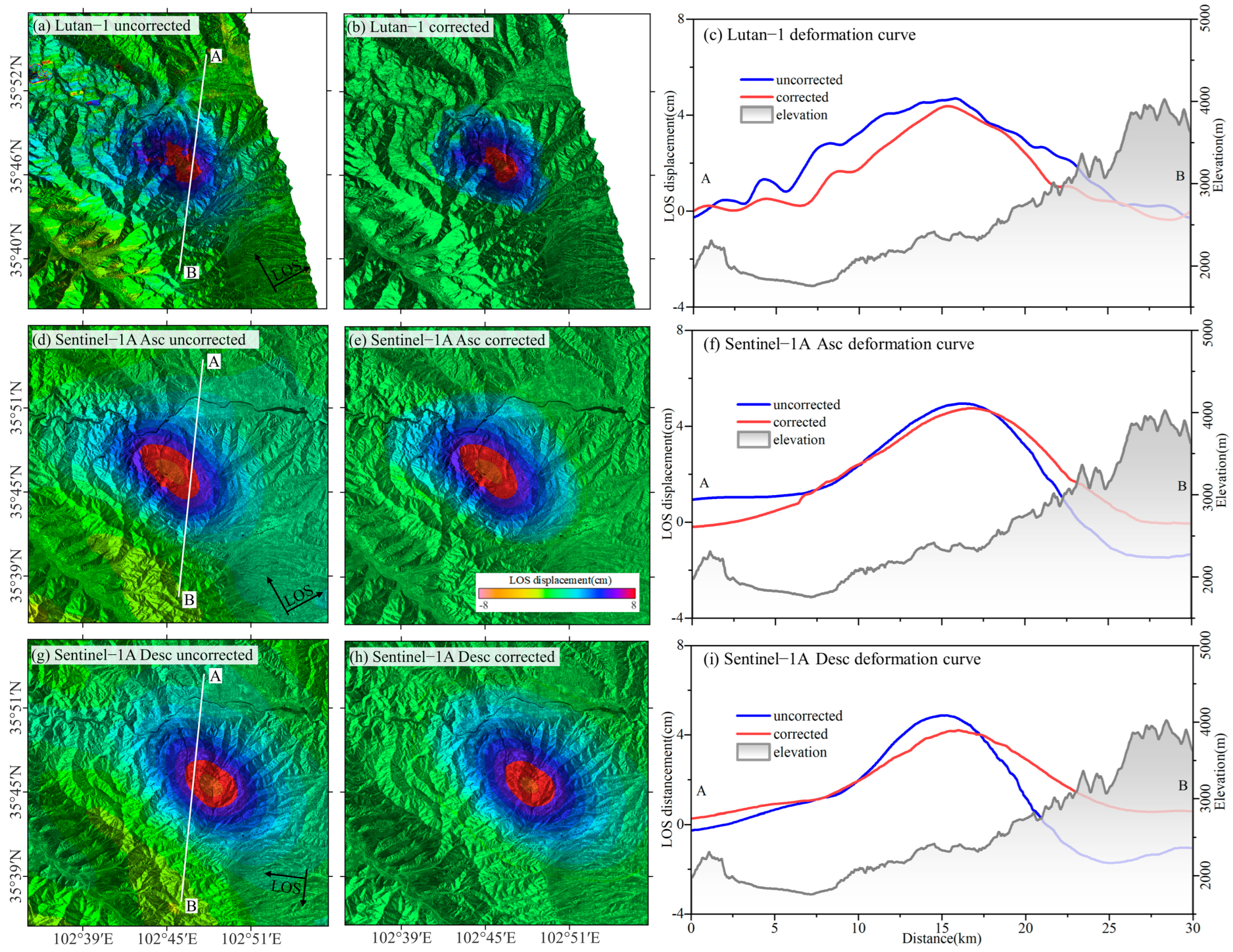
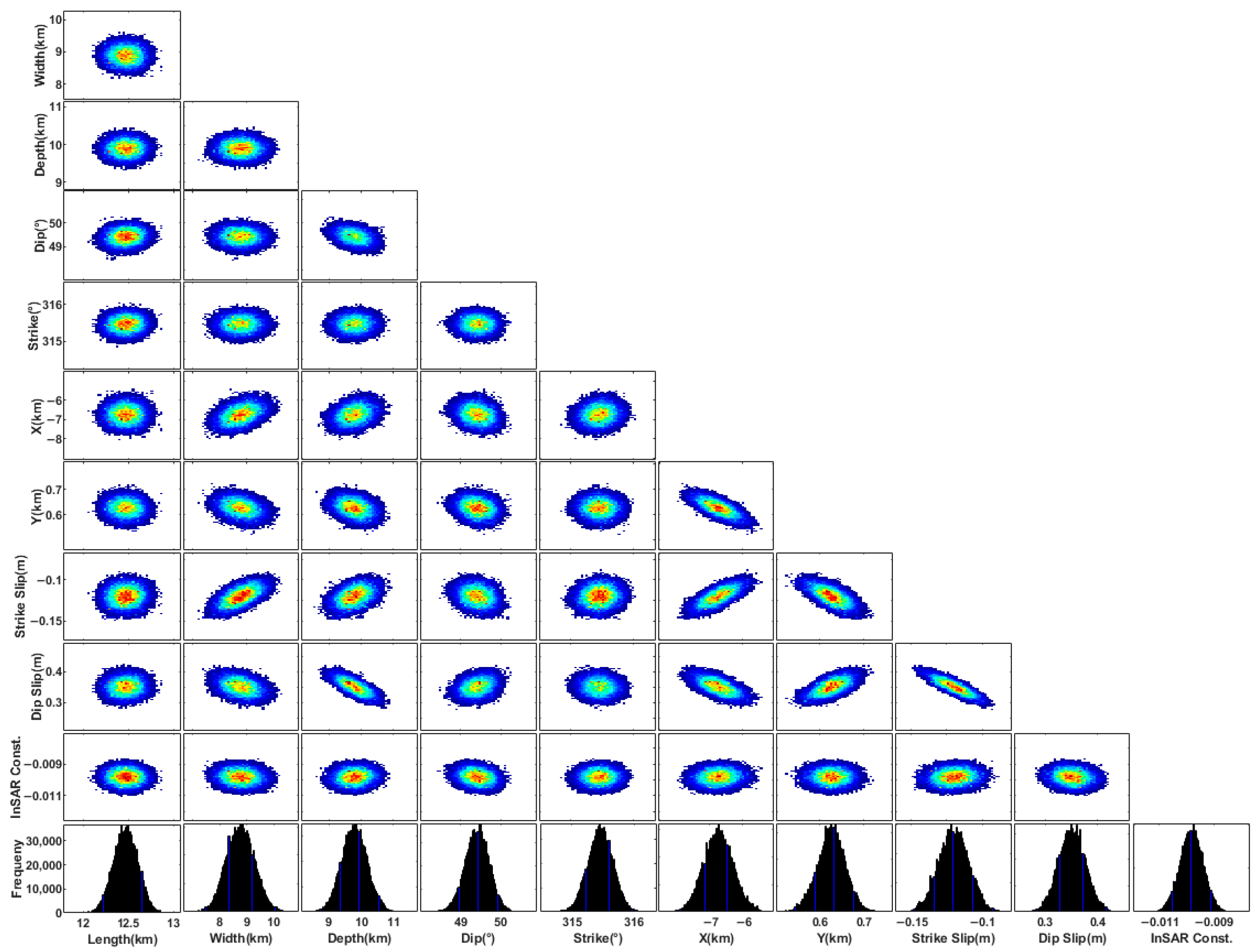
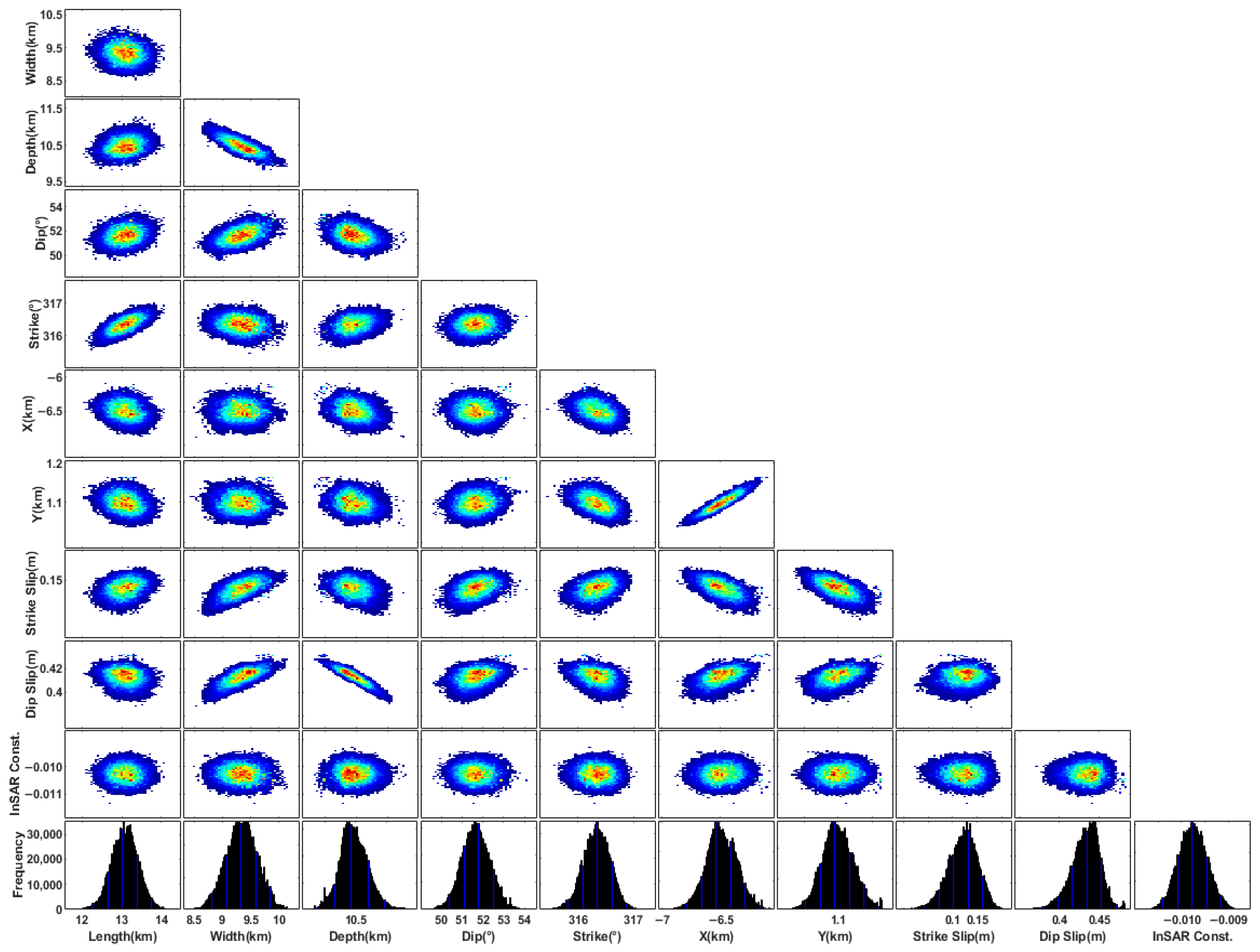
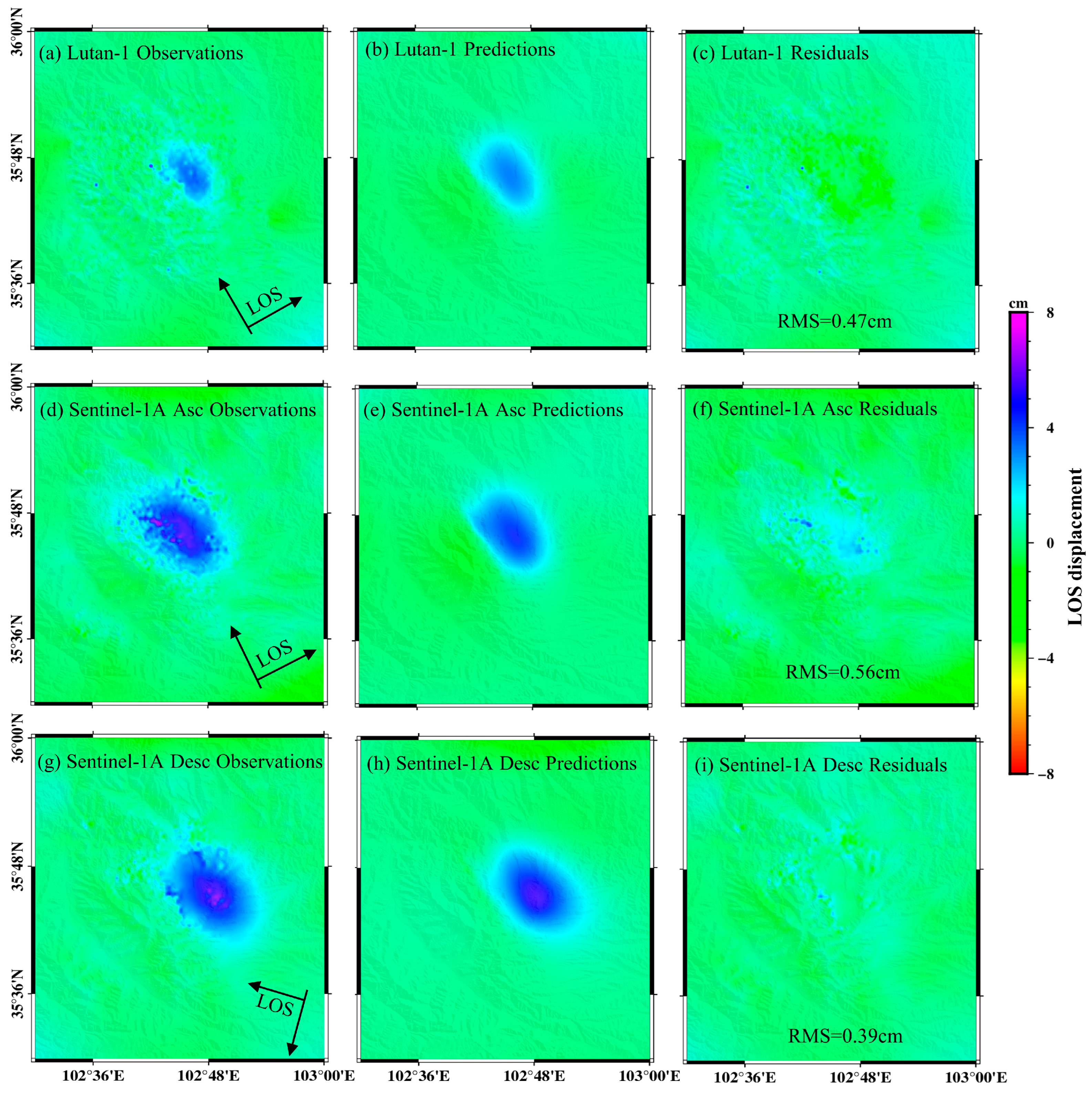
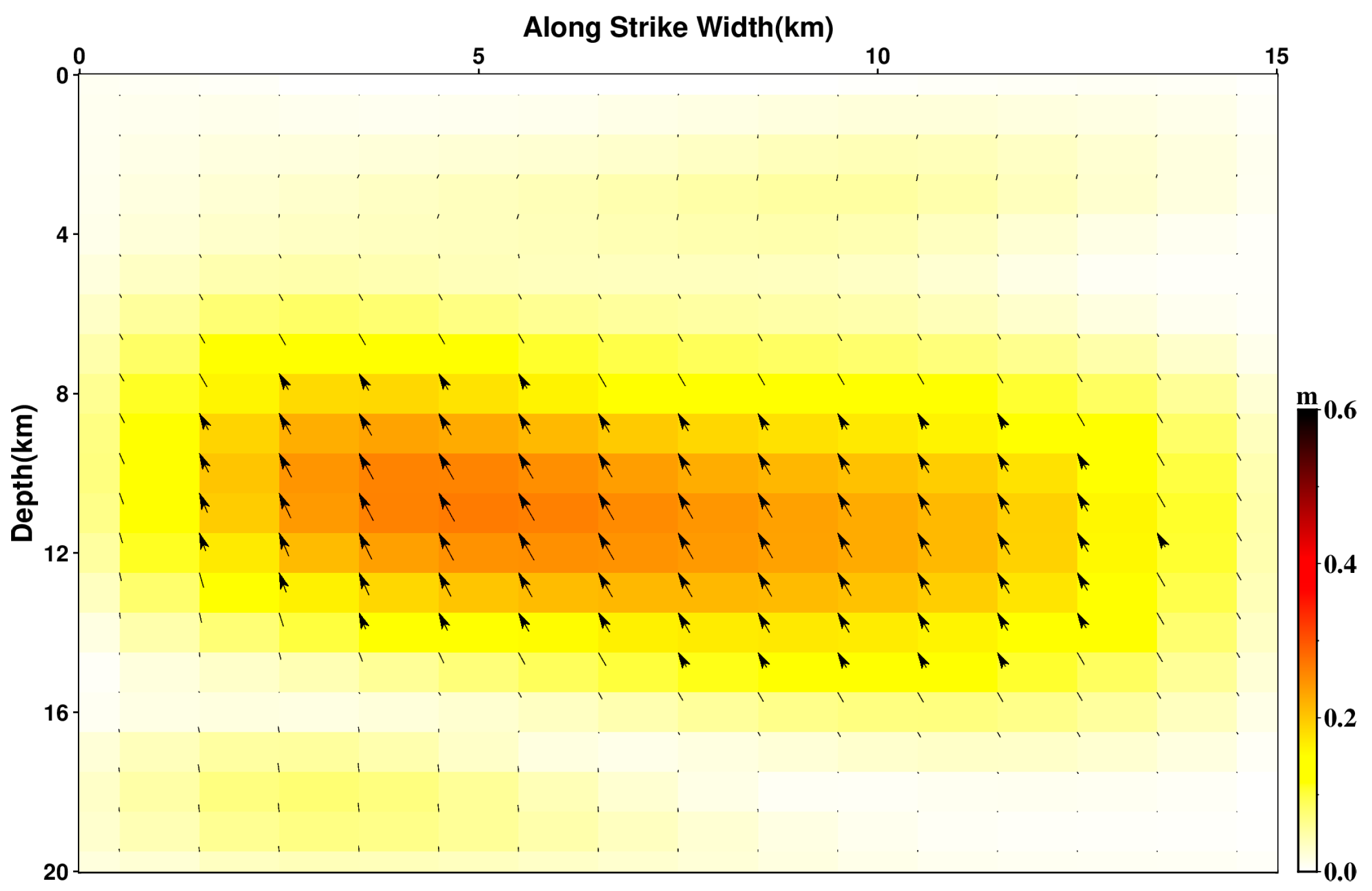
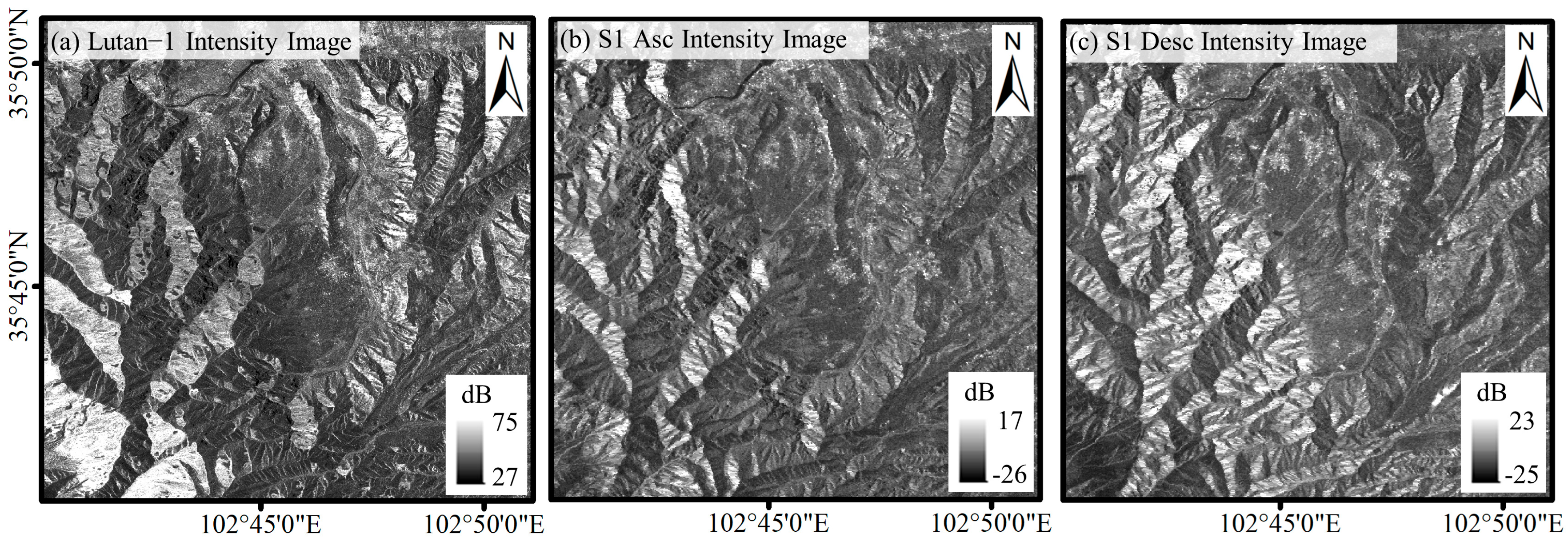
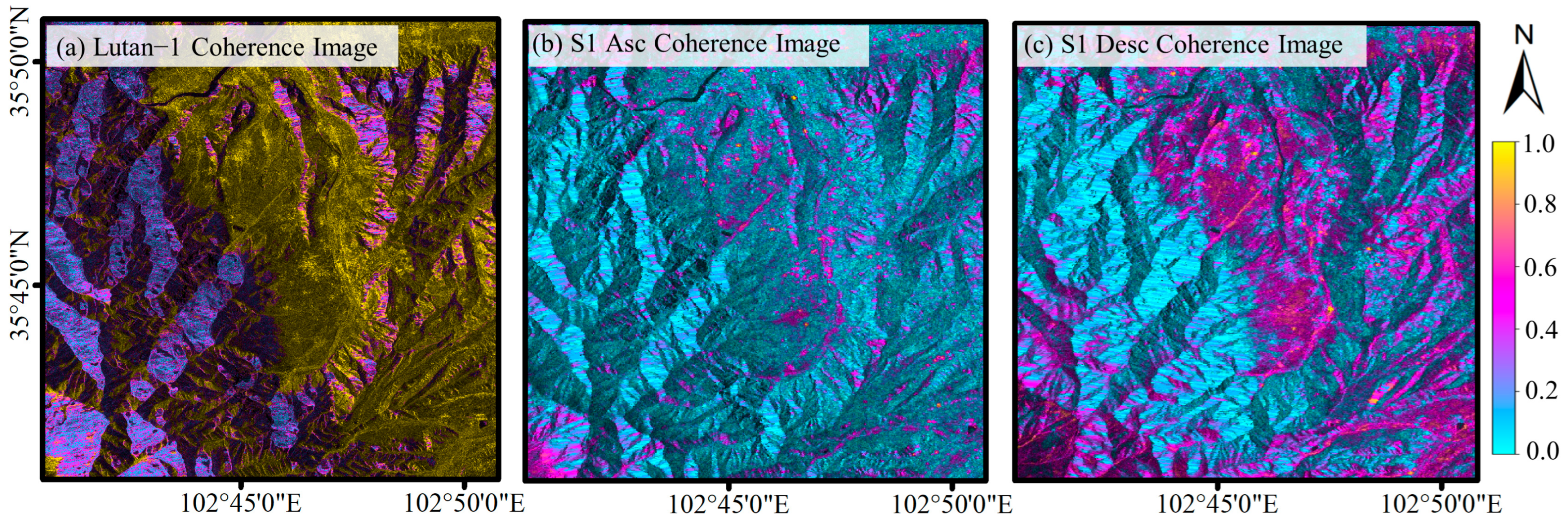
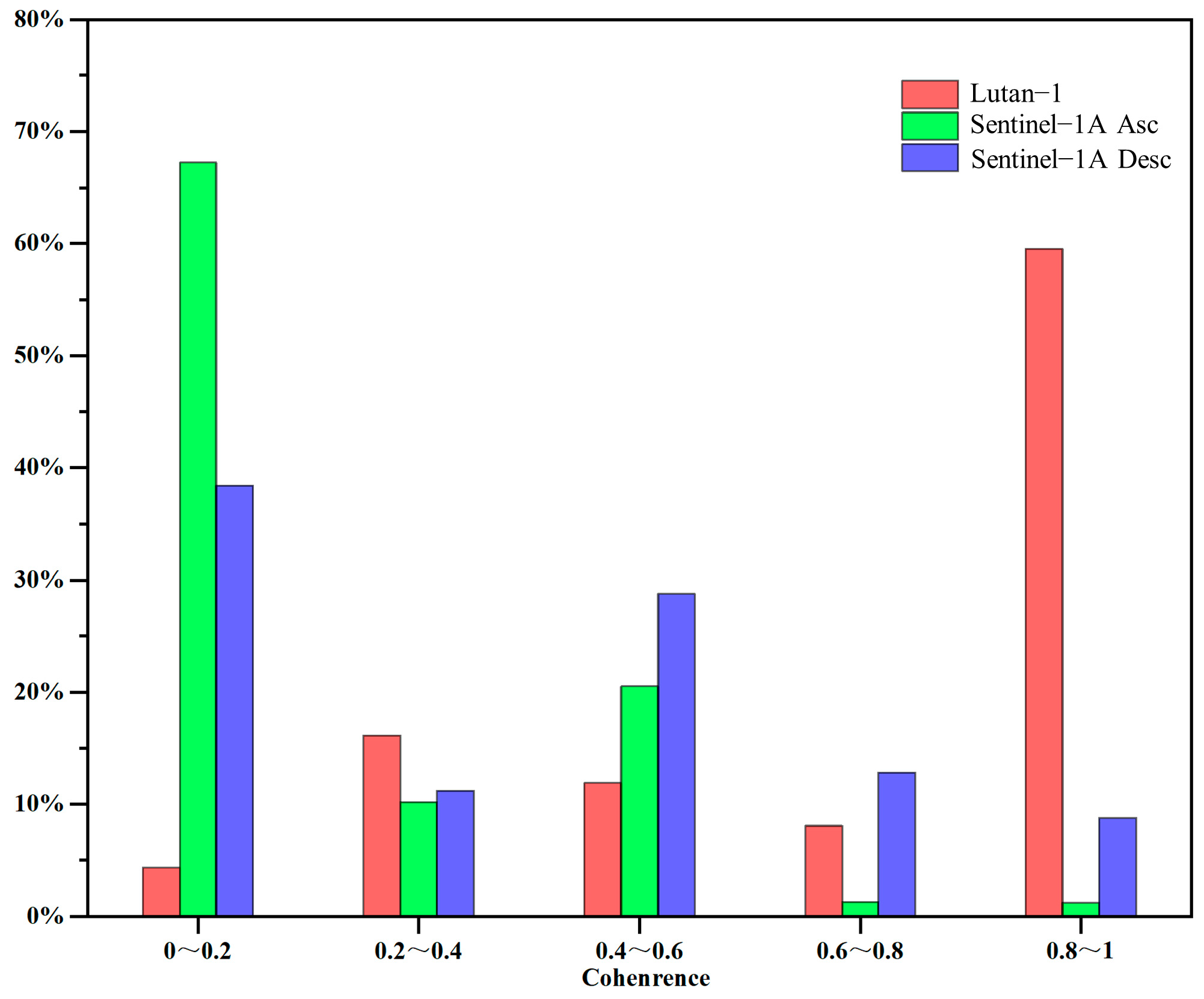
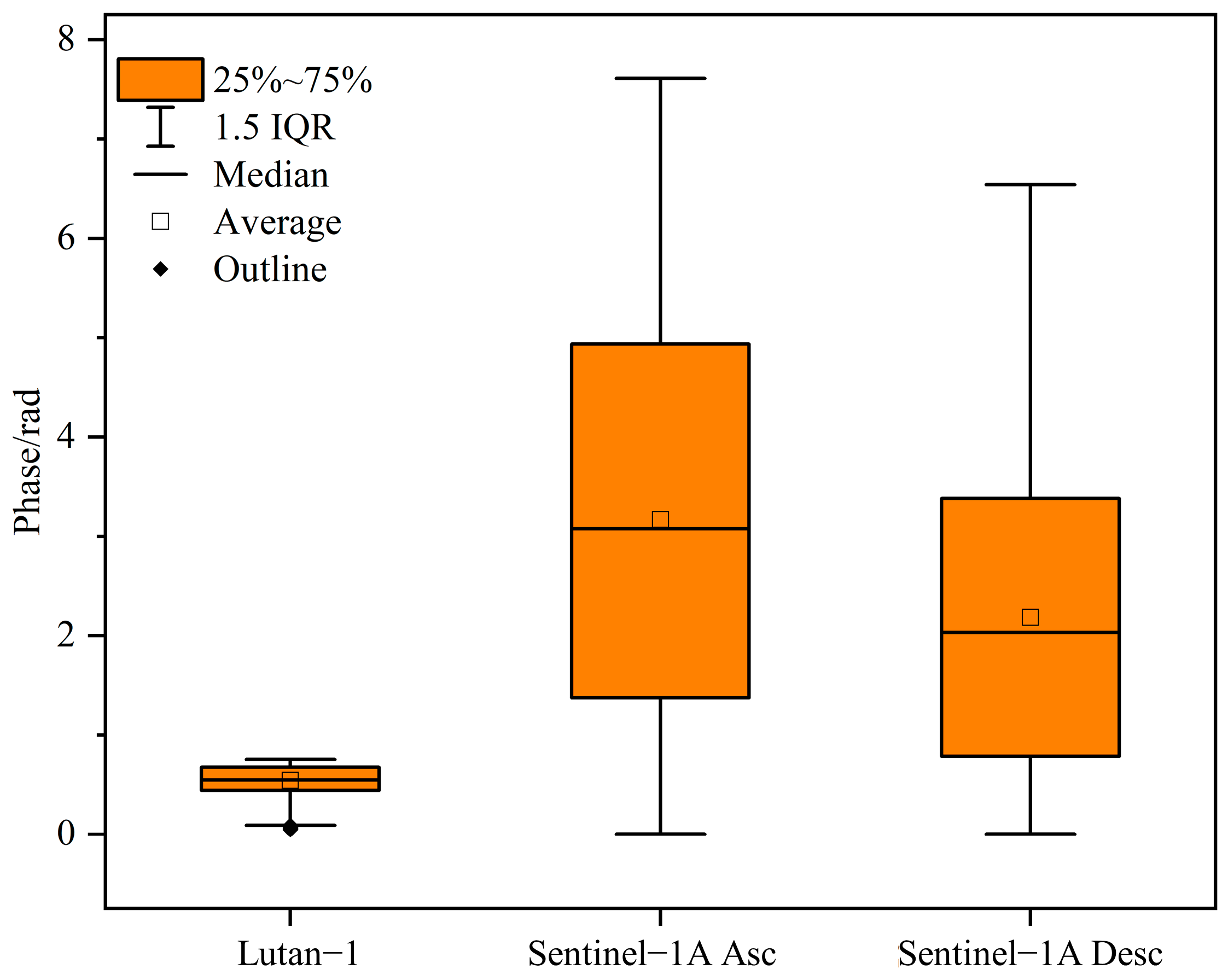
| SAR Sensor | Lutan-1 | Sentinel-1A | Sentinel-1A |
|---|---|---|---|
| Path | 128 | 135 | |
| Orbital direction | Ascending | Ascending | Descending |
| Reference date | 18 December 2023 | 27 October 2023 | 14 December 2023 |
| Secondary date | 22 December 2023 | 26 December 2023 | 26 December 2023 |
| Time baseline (day) | 4 | 60 | 12 |
| B⊥ (m) | 740.15 | 64.30 | 114.60 |
| Wavelength (cm) | 23 | 5.6 | 5.6 |
| Incidence (°) | 22.49 | 41.56 | 39.17 |
| Heading (°) | 348.63 | −13.12 | 193.12 |
| Pixel spacing (Range × Azimuth) (m) | 1.67 × 1.74 | 2.33 × 13.94 | 2.33 × 13.94 |
| Image wide (km) | 50 | 250 | 250 |
| Mode | Stripmap | TOPS | TOPS |
| SAR Sensors | Baseline | Bc (m) | Bn (m) | (m/s) | (m/s) |
|---|---|---|---|---|---|
| Lutan-1 | Initial baseline | 719.796 | −188.033 | −0.887 | −0.092 |
| Precise baseline | 717.589 | −187.211 | −0.848 | −0.141 | |
| Baseline deviation | −2.207 | 0.822 | 0.039 | −0.049 |
| Length (km) | Width (km) | Depth (km) | Dip (°) | Strike (°) | X 1 (km) | Y 1 (km) | Strike Slip (m) | Dip Slip (m) | |
|---|---|---|---|---|---|---|---|---|---|
| Lower | 0.5 | 1 | 0 | 0 | 200 | −10 | −10 | −5 | −5 |
| Upper | 50 | 50 | 25 | 89.9 | 360 | 10 | 10 | 5 | 5 |
| Step | 0.05 | 0.05 | 0.05 | 1 | 1 | 0.1 | 0.1 | 0.01 | 0.01 |
| Source | Length (km) | Width (km) | Depth (km) | Dip (°) | Strike (°) | X (km) | Y (km) | Strike Slip (m) | Dip Slip (m) | Mw | |
|---|---|---|---|---|---|---|---|---|---|---|---|
| Lutan-1 | Optimal | 12.67 | 9.25 | 10.14 | 49.36 | 315.38 | −7.12 | 0.66 | −0.13 | 0.35 | 6.0 |
| 2.5% | 10.89 | 7.51 | 9.05 | 48.12 | 312.95 | −7.84 | −0.18 | −0.15 | 0.28 | ||
| 97.5% | 14.15 | 11.14 | 11.32 | 50.47 | 317.69 | −6.33 | 1.35 | 0.17 | 0.46 | ||
| Sentinel-1A | Optimal | 13.12 | 9.37 | 10.77 | 51.76 | 316.54 | −6.57 | 1.13 | 0.12 | 0.41 | 6.0 |
| 2.5% | 11.39 | 8.67 | 9.68 | 49.75 | 314.41 | −7.29 | 0.45 | −0.06 | 0.24 | ||
| 97.5% | 14.52 | 10.58 | 11.83 | 53.52 | 320.72 | −6.02 | 1.76 | 0.31 | 0.58 | ||
| USGS | Optimal | - | - | 10 | 62 | 333 | - | - | - | - | 5.9 |
| GCMT | Optimal | - | - | 18.9 | 52 | 331 | - | - | - | - | 6.1 |
| Huang et al. [21] | Optimal | 13.16 | 10.96 | 15.03 | 55.9 | 320.4 | 18.47 | 12.68 | −0.01 | 0.32 | 6.0 |
| Liu et al. [22] | Optimal | 14 | 8 | 9.3 | 43 | 319 | - | - | - | - | 6.0 |
| Fang et al. [23] | Optimal | 12.96 | 7.96 | 5.54 | 32.2 | 325.2 | −6.45 | 2.87 | 0.1 | −0.249 | 6.2 |
| Source | 0~0.2 | 0.2~0.4 | 0.4~0.6 | 0.6~0.8 | 0.8~1.0 |
|---|---|---|---|---|---|
| Lutan-1 | 39,388 | 147,158 | 108,773 | 73,579 | 542,682 |
| Sentinel-1A Asc | 613,909 | 93,115 | 187,324 | 11,737 | 11,126 |
| Sentinel-1A Desc | 350,481 | 102,417 | 262,473 | 116,736 | 80,028 |
Disclaimer/Publisher’s Note: The statements, opinions and data contained in all publications are solely those of the individual author(s) and contributor(s) and not of MDPI and/or the editor(s). MDPI and/or the editor(s) disclaim responsibility for any injury to people or property resulting from any ideas, methods, instructions or products referred to in the content. |
© 2025 by the authors. Licensee MDPI, Basel, Switzerland. This article is an open access article distributed under the terms and conditions of the Creative Commons Attribution (CC BY) license (https://creativecommons.org/licenses/by/4.0/).
Share and Cite
Li, X.; Peng, J.; Zheng, Y.; Chen, X.; Peng, Y.; Ma, X.; Su, Y.; Shi, M.; Qi, X.; Jiang, X.; et al. Coseismic Deformation Monitoring and Seismogenic Fault Parameter Inversion Using Lutan-1 Data: A Comparative Analysis with Sentinel-1A Data. Remote Sens. 2025, 17, 894. https://doi.org/10.3390/rs17050894
Li X, Peng J, Zheng Y, Chen X, Peng Y, Ma X, Su Y, Shi M, Qi X, Jiang X, et al. Coseismic Deformation Monitoring and Seismogenic Fault Parameter Inversion Using Lutan-1 Data: A Comparative Analysis with Sentinel-1A Data. Remote Sensing. 2025; 17(5):894. https://doi.org/10.3390/rs17050894
Chicago/Turabian StyleLi, Xu, Junhuan Peng, Yueze Zheng, Xue Chen, Yun Peng, Xu Ma, Yuhan Su, Mengyao Shi, Xiaoman Qi, Xinwei Jiang, and et al. 2025. "Coseismic Deformation Monitoring and Seismogenic Fault Parameter Inversion Using Lutan-1 Data: A Comparative Analysis with Sentinel-1A Data" Remote Sensing 17, no. 5: 894. https://doi.org/10.3390/rs17050894
APA StyleLi, X., Peng, J., Zheng, Y., Chen, X., Peng, Y., Ma, X., Su, Y., Shi, M., Qi, X., Jiang, X., & Wang, C. (2025). Coseismic Deformation Monitoring and Seismogenic Fault Parameter Inversion Using Lutan-1 Data: A Comparative Analysis with Sentinel-1A Data. Remote Sensing, 17(5), 894. https://doi.org/10.3390/rs17050894






